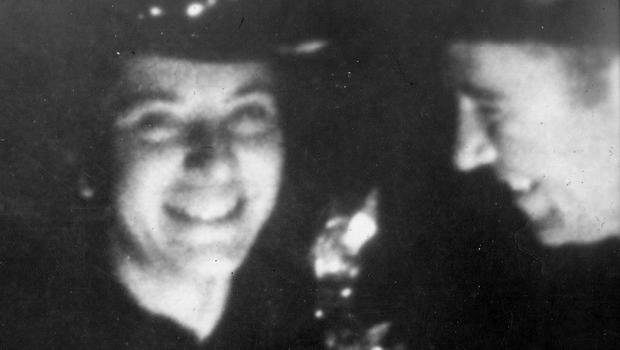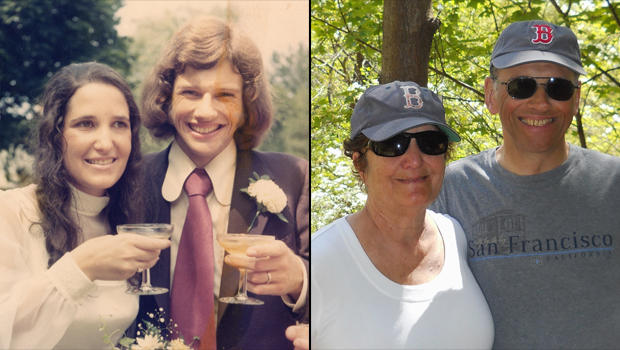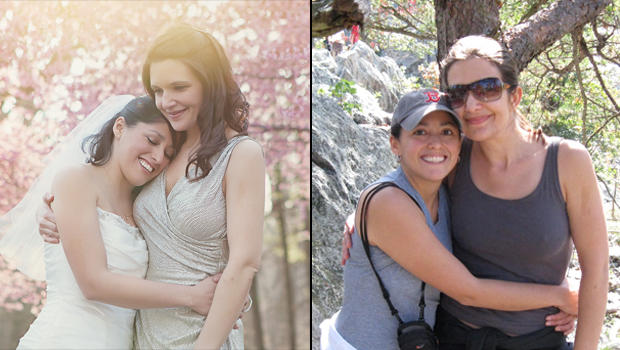Why marry? Three generations tell their wedding stories
Growing up, Lindsey Dawson never pictured herself as a wife.
"I thought marriage was just an institution and that it was sexist," said the 31-year-old public policy associate. And, although she believed same-sex marriage should be a right, Lindsey herself was "kind of disinterested."
That was, until she met Jessica Chipoco. They met on an online dating site after Lindsey moved to Washington, D.C.
Six months later they were living together. At nine months, they were talking about getting a house, and 20 months into the relationship they were anxiously watching TV on election night to see if they could get married in their state of Maryland.
"I didn't feel that [marriage] was something I needed for myself," Lindsey said. "But when I met Jessica, we decided we wanted to be committed...It just became, I wanted to advance our relationship further."
Marriage has always been evolving, but it's changed more dramatically in the past 100 years than in the past 1,000. And not just concerning who can marry -- also when people marry, and why.
A recent study sponsored by the National Marriage Project at the University of Virginia titled "Knot Yet" made a splash by analyzing how young people are viewing marriage as a "capstone" more than a "cornerstone" to their adult lives: Rather than the launching point for prosperity and happiness, marriage is more likely to be viewed as an endpoint after establishing "financial and psychological independence." Other recent data points to marriage as no longer being necessary in a successful life: The
Centers of Disease Control and Prevention foundthat almost half of all first births are born out of wedlock, and a 2011 Pew study reports that nearly four in 10 Americans believe marriage is becoming obsolete.Although the number of adults getting married is at a record low and more are finding the institution archaic, the dream of one day saying vows before an altar persists for many. According to the Pew study, most people who have never tied the knot -- 61 percent -- say they'd like to marry some day. Traditions in marriage have changed a lot since Lindsey's grandparent's generation, but one thing remains consistent: the desire to make it official.
Hyman & Estelle
Everyone in Lindsey's family knows the story of how her grandparents met. They danced for the first time at her grandfather's cousin's 25th wedding anniversary.
"Who's that skinny girl you were dancing with?" a relative asked Lindsey's grandfather, Hyman Sherman.
"That's the girl I'm going to marry," he replied.
Her name was Estelle. They were supposed to have a big wedding in April 1942, but there was a change of plans when Hyman was drafted overseas during World War II. Friends and family advised them to get married before he left -- that way, when he was out fighting, he'd have "something to live for."
Estelle and Hyman Sherman married in Estelle's sister's living room, just their siblings and parents to witness the moment of matrimony before a rabbi. The few wedding photos they have show two happy, glowing faces, his eyes locked on her smile -- there is no trace of plans and hopes soon to be disrupted by war. He went overseas for four years, and like many WWII couples, their interactions immortalized in dozens and dozens of letters.
Hyman and Estelle tied the knot on the eve of what could be called a marriage boom. While they got hitched relatively late -- both were 28 years old -- the pressure to marry young heightened after the war. The rate of marriage spiked all through the 1940s, before reaching a record high in 1950: by then, 78 percent of American households were occupied by a husband and wife, according the Pew Research Center. The median age of marriage was at its youngest in 1950, too; it dropped from 21.5 to 20.3 for women and from 24.3 to 22.8 for men within the decade.
Sound the Wedding Bells
Average age of first marriage, by year
The post-war era's thriving economy contributed to an American Dream that was as scripted as a "Leave it to Beaver" episode. About one in four women took jobs outside the home to fill in the labor gap left by men fighting overseas, but as the men returned, women were expected to return to their roles as housewives. Women often got married right after high school -- if they went to college, they'd joke it would be to get their "MRS," or Missus. Husbands brought in most of the dough, and would remain so for the next few decades: According to Pew research data, only 4 percent of husbands had wives whose income topped theirs in 1970, compared to 22 percent in 2001.
On Hyman's return, he and Estelle built a household that was not much unlike many of their neighbors'.
Hyman was the primary breadwinner, running a furniture store in the Boston area, although Estelle worked at the shop to help out. She was responsible for all domestic chores.
"My father did nothing!" recalled their daughter Syrel Dawson, laughing. "Because my mother took care of the house. She did all the cooking and dishes." And, with Syrel, four children to look after.
From what Syrel remembers, her parents had a happy marriage until her mother died in 1982 (her father died in 1997). Not all women were lucky. Before the sexual revolution and wide availability of safe birth control, being a single woman in the 1940s and 50s provided a tremendous amount of anxiety -- marriage often being the only way out. Pregnancy was something that constantly lingered in the back of every woman's mind.
"To be unmarried and pregnant in the 1950s was to be in the deepest kind of trouble," writes journalist Brett Harvey her 2002 book "The Fifties: A Woman's Oral History." "First of all, there was the shame; a kind of shame that's unfamiliar to girls now: a profound and overwhelming feeling that you were bad and dirty in the deepest part of you, that you'd done something irredeemable. Then there was the terrible quandary of what to do."
Most women knew little about abortion. Because it was illegal in most cases, woman resorted to word of mouth to find sympathetic doctors or much shadier -- and dangerous -- clinics. Dr. Alfred Kinsey's infamous "Kinsey Report" in 1953 found that 20 percent of sexually active single women in the survey underwent abortions.
While abortion remains a controversial subject, the stigma of sex out of wedlock has largely disappeared. In the 1980s, the average age of first child became younger than average age of first marriage, and in 2012, nearly half of first children have been born out of wedlock. In the 1940s and well into the 1950s, much of that shame is attributable to religion and the taboo of promiscuity. But most of all, there was nothing more pitiful than a single mother, supporting herself. Marriage was very much a part of wealth, identity and social class.
First Comes Love, Then Comes ... Carriage
Average age of women at first marriage, compared to average age of first birth 1967-2010
"Single motherhood was not a viable choice if you were white and middle class: The stigma was simply too crippling to live with. If you were black, your family and community might treat you with more compassion, but your life was irrevocably changed. The only option left, the one most white women took if they could, was marriage. But even marriage couldn't shield you from censure if your baby was born at 35 weeks," Harvey writes.
Mick and Syrel
Nineteen-year-old Mick Dawson came over from England to work at a summer camp in Massachusetts through a foreign exchange program in 1971. A coworker said he was going to go to his uncle's house, and Mick went along.
"He didn't mention that he had a beautiful young cousin," Mick said. A week later, he returned to the house to pick up a record he left behind while he was on his way to do laundry in Plymouth. The cousin, Syrel, took pity on the boy, carrying a laundry bag on his only night off, and offered to clean his clothes for him. She suggested he watch the game with her father, but Mick said "I'd rather talk to you."
The summer ended, and Mick had to return to England to finish school. But they continued to correspond through letters, which Syrel still keeps in a box. He came back the following summer for her, and she later took a trip to Brussels, where his family had been living.
"We were sitting in a little Belgian cafe," Mick recalled, "and I said, 'let's get married' and she went, 'but-but-but you're still an undergraduate,' and I said, 'just say yes." Although they knew each other for almost two years, they had only officially been dating for four months. "We'll figure it out," Mick said.
Both 21 years old, Mick and Syrel had a small and beautiful backyard wedding in 1973. While their parents were supportive, Syrel said many of her relatives didn't show up because Mick wasn't Jewish - he was an atheist raised in a Christian home. They wrote their own ceremony -- also unusual for their time -- but they wouldn't have found a rabbi to marry them, so they went before a justice of the peace the day before the ceremony.
Mick, who works at a biotech firm, and Syrel, a soon-to-retire teacher, are now both 60 years old and will be celebrating their 40th wedding anniversary this June. "I know how Mick and I are truly blessed," Syrel said.
Blessed indeed. If the 1940s and the 1950s were about the rise in marriage, the 60s and 70s were about the rise of divorce. The divorce rate doubled from 1960 to 1980, when there were about 22.6 divorces per 1,000 married women that year. By 1980, many states allowed what is called no-fault divorce -- the court no longer needed at least one spouse to have committed a crime or adultery as a grounds for divorce. Larry Bodine, a lawyer and editor-in-chief of Lawyers.com, says the spike is attributable for a number of factors: Divorce was easier, joint child custody became an option, and the stigma was largely gone.
"In the 1960s it would be the neighborhood scandal. By the 1980s, it was no big deal," Bodine said. Pop culture contributed to that attitude: "Prominent people, to some degree, are role models. Celebs are getting divorced, and it just makes it a more acceptable thing."
"I Do" or "I Don't"
Marital status from 1960 to 201
Additionally, interfaith marriages were very unusual. As Naomi Riley writes in her book "'Til Faith Do Us Part," the General Social Survey found that 15 percent of households were of mixed faiths in 1988. That eventually rose to 25 percent in 2006 and about 42 percent today.
Interfaith marriage, however, was never illegal in the eyes of American law -- couples could always find a justice of the peace to seal the deal. For much of American history, interracial marriage was not only socially unacceptable but was illegal. Up to 1967, it was still illegal for people of two races to get married in 15 states because of anti-miscegenation laws. After the Supreme Court deemed it unconstitutional, interracial marriage became more and more common. According to a 2008 Pew study, rates of intermarriages among newlyweds more than doubled between 1980 (6.7 percent) and 2008 (14.6 percent).
There were a lot of things Mick and Syrel did differently than their parents, but like them, they jumped into marriage without living together. Neither had a stable, full-time job. For them, getting married felt right -- the rest could be figured out later. As the "Knot Yet" study would describe it, their marriage followed a "cornerstone" model.
"We didn't have two pennies to rub together when we got married. Each night, we'd write everything in a cash book," Syrel said. "We'd turn our pockets out each night, and that was our lives as a couple."
But unlike the Shermans, they shared both money-making and domestic responsibilities. At first, Mick stayed home with their only daughter, Lindsey, while he was working on his Ph.D. When he got a job, Syrel stayed home with Lindsey for a year. Always on a budget, they rarely went out to eat or for entertainment in their first year as newlyweds. Instead, they'd often read books out loud to each other.
"We had to get to know each other. We would get to know each other by reading to each other," Syrel said.
Lindsey & Jessica
If the Shermans and the Dawsons had letters to anthologize their courtship, Lindsey and Jessica have online messages. Lindsey had just moved to Washington to continue her career in health policy. She signed up for the online dating site OKCupid. "Once I got there, I realized I didn't know any people," she said. "Honestly, I didn't really think about it that seriously."
Jessica, a 34-year-old attorney, received an OKCupid email alert. "I saw someone come up, and said, 'Oh, she's cute.'" At first, she was hesitant to get too committed because Lindsey was there on an internship. But then Lindsey found a full-time job, and soon it became clear that she was in D.C. to stay.
"It's really abnormal for both of us to jump into something quickly and be so sure of something, but it just clicked," Jessica said. She'd never imagined she'd meet someone to spend the rest of her life with.
"Growing up I assumed I would meet someone in college and get married. That didn't happen, and then I went to law school and still didn't find anyone," she said. "Once I felt completely okay with being a single person, I met Lindsey."
Considering the median age of first marriage is older than it's every been before, getting married in one's thirties is a regular thing these days. They tied the knot March 30 during a weekend-long ceremony by a cabin the Potomac woods, close to the hiking trail where they got engaged. But one could say they sealed the deal way earlier in a way more and more couples are, when they bought a house together in the suburbs outside the capital.
According to a recent survey by Coldwell Banker Real Estate, 24 percent of married millennials between the ages of 18 and 34 bought their home before they married, compared to 14 percent of couples who were over the age of 45.
Psychotherapist and Coldwell Banker consultant Dr. Robi Ludwig said for some couples, especially in the Northeast and Midwest, buying a home together is the new engagement.
"Couples right now are very fiscally aware," Ludwig told CBSNews.com. "If we're looking at the history of marriage, 50 years ago many women didn't know a lot about finances and put this responsibility, for better or worse, in their husband's hands," Ludwig said. "Now, we're getting married later, we have careers. If you want to be smart for yourself, you have to be financially responsible and aware."
The less legally binding form of cohabitation, leasing a space, is even more popular.
A recent study by the CDC found that 48 percent of unmarried women lived with their significant other. The number is a sharp increase from the 23 percent reported in 2002 and the 35 percent reported in 1995. Only 23 percent of the women surveyed said they got married to their boyfriends before living together. It's a trend Larry Bodine of Lawyer.com says he thinks is contributing to a steadily decline in divorce rates since 1990.Jessica and Lindsey both think it's necessary for a couple to live together before getting married. But they recognized what a huge risk buying a house was. "My mom was born in 1939," Jessica said. "Back then you would never move in with someone before getting married, but when it came to her daughter, she said I should do it."
They wouldn't be able to get married to begin with, however, if it weren't for the LGBT movement. On January first this year, Maryland began allowing gay and lesbian couples to get married. As of May 14, twelve states had legalized same-sex marriage.
The two said they would have gotten married this March regardless -- they would have gone to a courthouse in D.C. But being allowed to get married in the state they lived in, at a place that held so much meaning to them, was important to them. It meant Maryland took their marriage -- and love for one another -- seriously. The two also plan on adopting children someday.
"I was elated, overjoyed, relieved and overwhelmed at the same time," Jessica said. "One of our neighbors saw us out in the yard the next day, and she pulled over her car, and got out to give us a hug."
--
It's difficult to say what a typical married millennial couple is, because there really isn't one. Averages and numbers can point to trends, but married households in the 21st century vary so much from region to region, family to family. Marriage is no longer a prerequisite for success or motherhood, either, so why do people bother to get married at all?
Lindsey -- like her parents, and her grandparents -- say their answer is simple: "I was overwhelmingly in love with her."



